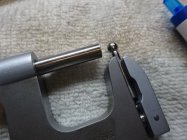Some time ago, one of the earlier times when components were scarce, I started to make some .22-250 brass from .308W. At some point, I am going to have to measure the case necks and turn them. I have a Forster Co-Ax Case and Cartridge Inspector, which is said to be able to measure neck wall thickness, but it uses a dial indicator. I also have a Neco unit, which may also do the same. I did not check if it does, but it also uses a dial indicator. I have seen units such as this "Brownells" (formerly Sinclair International) Case Neck Wall Thickness Micrometers.

 www.brownells.com
www.brownells.com
Which is the best way to measure? I am thinking the direct reading micrometer style tools vs. any of the units I have, or any other utilizing an indicator, but I am not really sure. The simplest and cheapest would be using what I have, but I also want to do it the best way.
Danny

SINCLAIR INTERNATIONAL SINCLAIR/STARRET CASE NECK MICROMETER | Brownells
The Sinclair Case Neck Micrometer is built around a Starrett micrometer head capable of measuring in .0001inch increments.This tool is designed specifically for handloaders to accurately measure case neck wall thickness. The micrometer head and an...
Which is the best way to measure? I am thinking the direct reading micrometer style tools vs. any of the units I have, or any other utilizing an indicator, but I am not really sure. The simplest and cheapest would be using what I have, but I also want to do it the best way.
Danny












